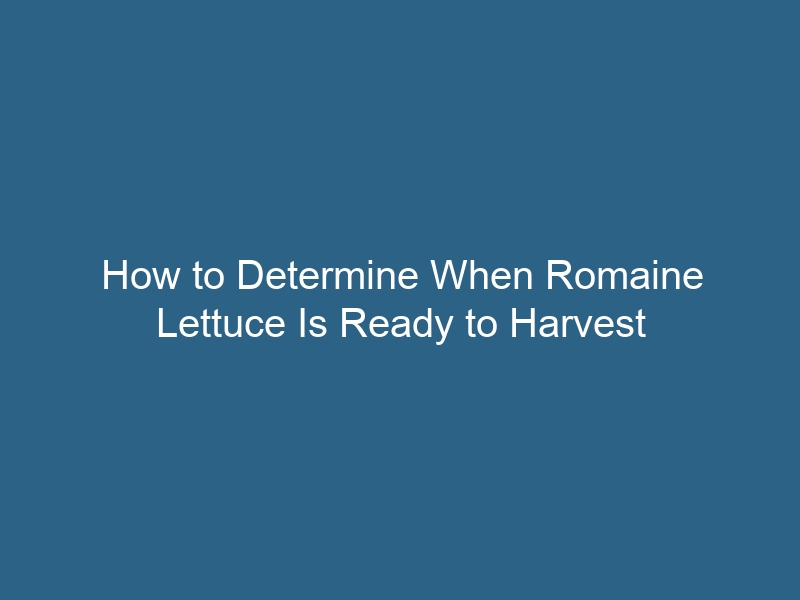Quck answer
Romaine lettuce is ready to be picked when the leaves are fully grown and firm. Look for leaves that are dark green in color and have a crisp texture. Avoid picking leaves that are yellow or wilted, as they may indicate that the lettuce is overripe or past its prime. To harvest the lettuce, simply cut the outer leaves at the base of the plant, leaving the inner leaves intact so that the plant can continue to grow. Remember to wash the lettuce thoroughly before consuming to remove any dirt or debris.
Romaine lettuce, like all other lettuce varieties, is a type of cool-season plant. Usually, romaine lettuce is ready to be harvested around 70 to 75 days after it has been planted. However, eager home gardeners don’t have to wait that long to enjoy the results of their hard work. Instead of waiting for the lettuce to fully mature, you can start incorporating tender romaine leaves into your salads and sandwiches when they are still young. Some people even prefer the taste of younger leaves over fully mature ones.
Harvest as You Go
When your romaine lettuce reaches a height of about 5 or 6 inches, it is in the baby-leaf or mini-head stage. At this point, you can begin to harvest some of the crisp green leaves while allowing the plant to continue growing. To do this, select leaves from the outer part of the plant that are free from rot or wilting and cut them off about 1 inch from the stems. Only harvest a few outer leaves from each plant, allowing the center leaves to mature further.
Harvest at Full Maturity
Your plants have reached full maturity when the leaves are elongated and slightly overlapping, forming a head that is approximately 6 to 8 inches tall. Typically, this occurs around 70 to 75 days after germination, although different varieties may require slightly more or less time. For example, the ‘Paris Island’ cultivar takes a bit longer to mature, while ‘Green Towers’ is an earlier variety.
Harvest the heads when the ribs along the bottom-center of each romaine leaf are fully developed but not excessively large or thick. If the lettuce is left on the plant for too long, the ribs of romaine will turn a milky color. A solid rib indicates that the romaine is mature, while a milky color suggests a tougher and more bitter lettuce. Check your lettuce daily to avoid waiting too long to harvest. Using clean pruning tools, cut the head close to the leaf stem, approximately 1 inch above the soil line. Alternatively, you can also harvest the entire head when it is still immature and in the “baby” stage for tender greens.
Obtain a Second Harvest
Since romaine lettuce prefers cooler temperatures, around 60°F, it is possible to obtain a second harvest from the heads that have already been harvested. If you cut the whole-head romaine about 1 inch above the soil line, new leaves will start to grow. Just like the first time, harvest the outer leaves when the plant reaches a height of about 5 inches, and then cut down the entire head when the leaves are 6 to 8 inches tall and slightly overlapping.
Potential Issues
There are several problems that can hinder a successful lettuce harvest. One such issue is tip burn. If the tips of the leaves turn brown, simply trim off those edges with clean scissors and then proceed to harvest the remaining leaves or allow them to continue growing. This problem is often caused by hydration issues, so make sure you provide your lettuce with frequent light watering.
During long and hot days, your romaine lettuce may start to produce flower shoots, a process known as “bolting”. To encourage a second harvest, you should cut down the entire plant, leaving only 1 inch of stalk. Additionally, you can try using shade cloth in the area to provide cooler temperatures. It is important to harvest the lettuce as soon as you notice any signs of bolting, as it may develop a bitter taste. After washing the lettuce, store it in the refrigerator and after a few days, the bitter taste may diminish.
Occasionally, gardeners may observe their lettuce turning yellow. This can be a result of the mosaic virus, which is transmitted by aphids and leafhoppers. Unfortunately, there is no cure for this virus. To prevent its spread, infected plants should be promptly removed. Regular weeding and mulching with aluminum mulch can help keep these insects away from your plants. Alternatively, you can try growing lettuce cultivars such as ‘Paris Island’ and ‘Valmaine’, which are resistant to the mosaic virus.


